|
What is a fasting
girl?
Fasting
Girls were girls or women in the Middle Ages who
were said to eat little or nothing and yet live. These
girls were also sometimes said not to
defecate or sweat or menstruate. This
was thought of as miraculous as well as curious, and these women and
girls drew
a lot of attention from regular people and the church. People
came to see them, give them money,
learn what God had revealed to them (if anything), and basically
treated them
as if they were holy, if curious, persons.
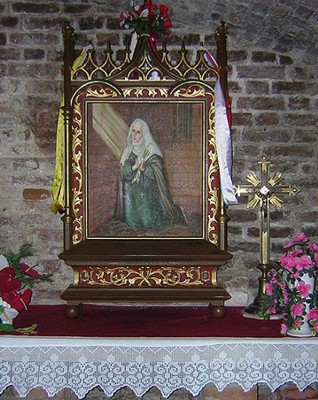
Dorothy of Montau (b.
1347), her image at the center of this shrine, began practicing severe
fasting even as a
child. As a woman she lived as a hermit
and fasted to the point where she stopped defecating.
When taking communion, she fell into fits of
ecstasy. (Photo from Wikipedia, by Marcin
N, 2006, creative commons sharealike license.)
The term ‘fasting girl’
may have been popularized by the
political pamphlet writers in England
during the English Reformation, when King Henry VIII separated England
from the Catholic church and created the Church of England.
What is fasting?
Fasting
has long been an activity of those of all faiths who
seek spiritual health and connection. Fasting at its most basic simply
means that
a person does not eat certain foods. Today,
we often associate fasting with a toxin cleanse, such as the grapefruit
diet. But long ago (and still today),
fasting was primarily about spiritual
health. People avoided foods that they
felt kept them
from communion with God.
Fasting in medieval
and early Christianity:
Medieval
Catholics practiced extensive fasting. Throughout
the middle ages in the West, the
week was divided into “lean days” and “meat days.” On
lean days (which were 'fast days'), you could eat fish, birds,
eel, or even beaver tail (which was
considered ‘fish’), and drink almond milk. Meat or milk from four
legged
creatures, including butter and cheese, could be eaten only on meat
days. If you ate meat on a lean day, you had to go to confession
and confess it.
Where
does this meat vs fish thing come from? Many
cultures have dietary restrictions as
part of their religious expression. But
Christian ‘lean day’ fasting probably came in part from the ancient
Greeks who
applied their philosophies of ‘world vs spirit’ to early Christian
theology and
practice. The idea was that lean day foods
were more spiritual and less corrupted by the world than were the meat
day
foods. Food of and from the air and
water, like fish and birds, was ‘purer,’ or higher up on the spiritual
ladder, than
food that came from goats, sheep, or cows.
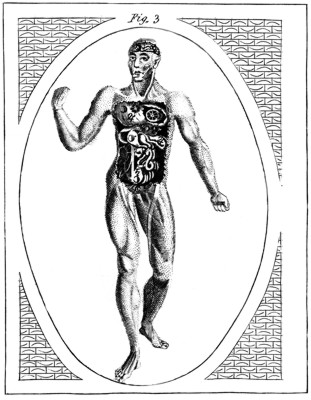
In this
illustration, we see ‘Man.’ Originally created with God-like power, he
is now corrupted by the fall of Adam and
Eve, a fall that took him from the spirit/God realm to the corrupt
world of
flesh. ‘Man’ is now contaminated by sin
and flesh and earth, and is susceptible to corruption and disease. (Illustration from Ebenezer Sibly, 1806,
posted
on fromoldbooks.org.)
Early
Greco-Roman Christians may have inherited the idea of
dietary restrictions for religious reasons from the Hebrews, but they
applied
it in a very Greco-Roman way. Regardless,
fasting became a predominant form of
religious expression in Christianity. Fasting
was associated with Godliness and miracles. Those
who engaged in fasting as a rigorous
practice could be said to be creating or expressing a ‘hunger for God’
that at
times became ecstatic or overwhelming. Fasting,
could be, and sometimes was, practiced to the
extreme.
Spiritual athletes:
Early
devout Christians flocked to the desert and lived in
little cells or caves or single room dwellings. (See
my article What
is an Anchorite?) Desert monks and
hermits (both men and women) prided
themselves on their
ability to abstain from food. That these
men and women could live without seeming to eat anything showed their
spiritual
vigor. Some claimed they did not eat
food at all. (See the interesting modern case of Prahlad Jani
) There are also many stories about monks pretending to eat for
appearances
sake, while instead hiding the food in their sleeves or under cloths
and later
giving that food to someone else.
People
who lived when they did not eat (or ate very
little) were thought to live by their spiritual strength (or by
spiritual
intervention) alone. Some of these desert men and women relate
instances where
they consumed spiritual food delivered to them by angels.
They believed that in their extreme fasting
and other practices, that they were leaving suffering and the world
behind them. They hoped that through
prayer and meditation
and endurance, they could escape the “corruption” of Man on earth and
live by
spirit alone. In their feats of
endurance, suffering, starvation and hardship, they were called
spiritual
athletes, and they often drew crowds of admirers to see them and
consult with them.
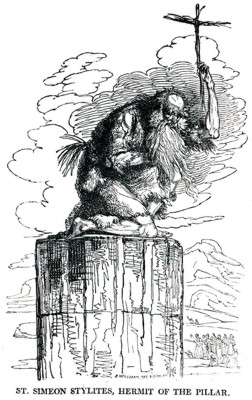
The Syrian Saint Simon (Symeon) was
one such spiritual athlete. He lived for
more than 30 years on a small platform on top of a pole. Theodoret
of Cyrrhus tells us: “ Night and day he is standing within the view of
all…now
standing for a long time, and now bending down repeatedly and offering
worship
to God….In bending down he always makes his forehead touch his toes—for
his
stomach’s receiving food once a week, and little of it, enables his
back to
bend easily…”
(Theodoret quoted by William
Harmless, Desert Christians, 2004, page 465. Image from Hone's Everyday
Book, 1826, posted on fromoldbooks.org)
The
Desert men and women became the monks (a Greek word) and
nuns of the middle ages. These spiritual
athletes (also called ‘aesthetics’ who practiced aestheticism) were
discouraged
by church and government. Too many
people communing so directly with God was disruptive and chaotic. Additionally, people like St. Benedict
recognized that such practices were far too extreme to be healthy, and
he
encouraged his followers to be more moderate. Still,
however, Benedict continued to advocate regular fasting.
Many of
the saints of the Middle Ages practiced at least
some kind of fasting. Though the church
discouraged extremes, spiritual athletes persisted, popping up in the
middle
ages as both religious monks and nuns and lay men and women. They often earned a good deal of admiration
and respect from those around them and their reputations could be
widespread. People thought their ability to
ignore their
own suffering (to deny the body) proved them to be spiritually strong
or blessed
and so closer to God. Or, if fasting did
not seem to bring them suffering, they were admired for their
miraculous
ability to not eat and yet not
to suffer.
Women saints who
fasted:
In the
medieval period, the importance of care of the soul
far outweighed the importance of care of the body. Today
we spend a great deal of time and
energy caring for our bodies, exercising, outfitting, and botoxing them. We have a hard time understanding, then, how
historically
it was care of the soul that was of vital importance, even if that
meant
suffering for the body. (See my article
on Medieval
Hospitals.)
In the
medieval context, fasting becomes an expression of
the soul over and above the needs of the body. The
spiritual soul manifested through the body in a number of different
ways. Fasting was only one manifestation of extreme aestheticism. Women and girls were also known to have
stigmata, to levitate, to leak or ooze bodily or mysterious fluids, to
disfigure
their bodies or otherwise attempt to render themselves unattractive,
shut
themselves away in small cells, and be swept into fits of hysteria when
receiving the Eucharist (or when thinking of the Eucharist). A number of them claimed the only ‘meal’ they
ate was the Eucharist itself. (Eucharist is also called Communion, it
is the Christian ceremony that distributes bread as the body--usually
only a small wafer--and wine as the blood of Christ.)
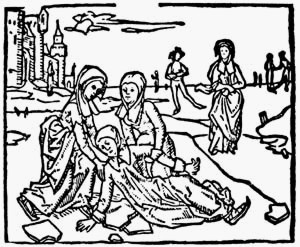
Saint Lidwina of Schiedam
(b. 1380) tried to disfigure her pretty face. Later
she suffered an accident that lead to a
gangrenous disease that
caused pieces of her body to fall off. She
is said to have been able to taste the difference between bread that
had been
consecrated to God, and bread that had not. (Image from a woodcut, from
wikipedia commons.)
Some of these fasting women
sought to escape marriage, or were
dealing with other issues of suffering in their lives that seemed to
manifest
in extreme behaviors. Perhaps their
often extreme focus on receiving the Eucharist as an actual (and only)
meal
came from some inner compulsion to deal with the troubles of their
lives. Regardless, these women were both feared
and
admired.
Women
such as Joan the Meatless could be simultaneously threatening
to the power structures of the church, and good for promoting miracles
and the
worship of saints. The church, therefore, put a lot of effort into both
containing these women and girls, and chronicling their exploits. Those women who became saints, such as in the
case of Christina the Astonishing, were often made the patronesses of
the very
things they seemed to suffer from most in their attempt to imitate the
sufferings of
Christ. Christina the Astonishing is the patron saint of insanity,
mental disorders, madness, lunatics, and mental health
providers.
Feasting on
spiritual food:
Visions
and fits of ecstasy were common in women who
fasted. Their visions were often
recorded and circulated by priests who served as their confessors. Both lay women (ordinary Christian women, not nuns)
as
well as religious women could express their faith through fasting and
ecstatic
fits.
In the
cases of religious women, where it is the Eucharist
itself triggers the fits, it seemed clear that such ecstasies must have
come
from God. But things could be more
difficult for lay women, as sometimes these fits were considered
annoying to
one’s neighbors. Certainly this was true
in the case of the fit-throwing Margery Kempe, who regularly disrupted
church
services by throwing herself into the aisle and flailing around in
ecstasy. Because Margery was a lay woman, a lot
of energy
was spent in determining if her fits came from God or the Devil. She visited bishops and submitted to their
examinations. Lucky for her, her experiences were authenticated by the
church. Joan of Arc was not so lucky.
These
women (and men, too) were generally called mystics,
for their religious expression was often visionary and accompanied by
many
kinds of wonders, such as levitation. But
fasting was a common thread and women and girls
who fasted often
claimed, as the desert hermits had as well, to live from spiritual food. In the case of these women, the food could
spontaneously fill their mouths in the form of blood or honeycomb. It was delivered to them by angels, saints,
the Virgin Mary, or Jesus himself.
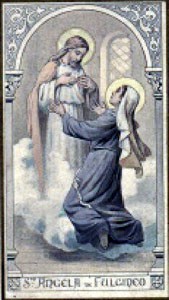
Angela of Foligno (b c.1250),
was a
nun who took
only the Eucharist while enduring long periods of
fasting. Christ as nourisher comes through
in this
image, where Christ seems to reveal his breast as
Angela receives a spiritual
food in the form of blood
(or milk?) from him. (Image from wiki
commons.)
Images
can show nuns or abbesses drinking the blood of Christ as it
oozes from the wound at his side, either into a chalice or directly
into their
mouths. In some of these images,
Christ’s wound is raised high on the chest and his action seem to
imitate lactation. Lactation (breast feeding)
was an act of deep
caring and sustenance, and though today breastfeeding can embarrass us,
we still use phrases like ‘The milk of human
kindness.’
Is this Anorexia
Nervosa?
No. The
manifestation of fasting as an extreme spiritual
practice has nothing to do with Anorexia. Today
we understand Anorexia Nervosa as a particular
kind of
disease. In the Middle Ages, things were
culturally and socially very different. People
still suffered from anxiety and depression and, no doubt, food
disorders. But there is nothing to say
that these woman and girls (and men, too) were anorexics.
Importantly, many of the girls who supposedly
ate nothing but communion were also said to look healthy and well, and
this,
you see, is also part of the miracle.
Some
researchers have likened the fasting girls of the
middle ages to girls today suffering from Anorexia. I
can see why they do, because there are no
doubt similarities. But I worry that
likening Fasting Girls to Anorexics romanticizes a terrible modern
disease and
misconstrues an ancient spiritual (if extreme) practice.
Should girls today
practice this kind of fasting?
No! Again, this
behavior comes out of a very different time and place. Girls
today shouldn’t wear corsets, either. Today we understand fasting and the body
differently than we did then. If you would like
to
undertake a fast for health or spiritual reasons, read some good books
on
modern fasting and good health, and talk to your pastor, spiritual
advisor,
dietitian, or doctor. Remember, we
understand today that the body is a beautiful expression of God’s
creation. Fasting together with good and
healthy diet
is supposed to be a healthful and beautiful thing.
Suggestions for
further reading:
If you like historical
fiction, follow my mystic nun
protagonist in The Saint and the
Fasting Girl
Find more articles and information at
my website historyfish.net
For a fascinating non-fiction tour de
force of women saints
and abbesses and other religious women read Holy Feast Holy Fast by Caroline
Walker Bynum and Forgetful of their
Sex by Jane Tibbetts Schulenburg. These
scholarly books chronicle the lives of women from the religious east
and west
who endured (or sought out) tremendous physical hardship in a quest of
extremism, seeking to live as Christ lived and to endure as Christ
endured.
I also recommend the book Memoirs of a Medieval Woman: The
Life and Times of Margery Kempe, by Lois Collins, Harper
Perennial, 1983.
Sources:
Holy Feast Holy Fast by Caroline
Walker Bynum, University of California
Press, 1988.
The Lives of the Desert Fathers
translated by Norman
Russell, Cistercian Publications,1980.
Desert Christians by William Harmless,
Oxford University
Press, 2004.
Forgetful of their Sex by Jane
Tibbetts Schulenburg, University
of Chicago Press, 1998.
The Art of Cookery in the Middle Ages
by Terence Scully, Boydell
Press, 1997.
The Book of Margery Kempe, translated
by John Skinner,
Penguin Classics, 2000.
Go to the monastics
homepage on historyfish.net
|
